Rheological Properties of Composite Inorganic Micropowder Asphalt Mastic
Abstract
:1. Introduction
2. Materials and Tests
2.1. Materials
2.1.1. GTCM
2.1.2. Asphalt
2.2. Preparation of GTCM Asphalt Mastic
- (1)
- Weigh the dried asphalt after quantitative dehydration. Based on the quality of asphalt and the content of GTCM, titanate coupling agent TC-131 and quantitative dry GTCM were weighed and well combined. When the asphalt is heated to good fluidity, the uniformly mixed powder material is poured into it, and one side is added for manual stirring for 5 min.
- (2)
- The high-speed shearing instrument was started. First, after shearing and dispersing at 1000 rpm for ten minutes, the speed was increased to 3000 rpm for thirty minutes. The rotor was taken out of the mixing barrel by adjusting the speed, and the temperature of asphalt in the modification process was controlled at 150 °C.
- (3)
- To get rid of the air bubbles in the GTCM-modified asphalt, it was manually stirred with a stirring rod for 10 min before being placed in storage.
2.3. Basic Performance Test Method
2.4. Test Method for Rheological Properties
2.4.1. Test Method for Dynamic Shear Rheological Properties
2.4.2. Low-Temperature Rheological Property Test Method
2.5. FTIR Spectral Analysis Method
3. Result and Discussion
3.1. Basic Performance
- (1)
- The temperature sensitivity of GTCM-modified asphalt is superior to tourmaline micropowder-modified asphalt under the same circumstances, and the improvement impact is more pronounced the more graphene micropowder is present. Compared to tourmaline micropowder modified asphalt, the temperature sensitivity of composite micropowder modified asphalt is increased by up to 87.2%.
- (2)
- The high-temperature stability of asphalt changed with GTCM is superior to asphalt modified with tourmaline micropowder under the same circumstances. The improvement effect is more significant with higher graphene micropowder content. Compared to tourmaline micropowder modified asphalt, the GTCM-modified asphalt showed a 6.35% improvement in 25 °C penetration, 7.62% improvement in softening point, and 7.17% improvement in equivalent softening point.
- (3)
- Under the same circumstances, the anti-aging performance of asphalt modified with composite micropowder is superior to that of asphalt modified with tourmaline micropowder. Additionally, the higher the content of graphene micropowder, the more significant the improvement effect. In comparison to tourmaline micropowder modified asphalt, the GTCM-modified asphalt showed an improvement of 8.60% in 25 °C penetration residual ratio and 57.58% in softening point increment.
3.2. Dynamic Shear Rheological Property Analysis
3.2.1. Temperature Scanning
- (1)
- Similar to matrix asphalt and tourmaline micropowder modified asphalt, the complicated shear modulus change trend of various types of GTCM-modified asphalt is the temperature under the same dose. Temperature increases cause an exponential decline in the complex modulus, indicating that the GTCM is used for modified asphalt. Asphalt’s viscoelastic characteristics remained the same, but the complex modulus of different types of GTCM-modified asphalt at the same temperature was higher than that of tourmaline micropowder modified asphalt and matrix asphalt.
- (2)
- Similar to matrix asphalt and tourmaline-modified asphalt, the phase angle of GTCM-modified asphalt has the same content. Additionally, the phase angle increases with temperature. During dynamic mechanical testing, the phase angle δ of stress and strain hysteresis indicates the ratio of viscosity and elasticity of viscoelastic materials. The phase angle of completely elastic material is 0°, and the phase angle of completely viscous material is 90°, while the phase angle of viscoelastic material is in the range of 0–90°. The phase angle of various asphalt kinds is within 88° as the temperature rises from 30 °C to 80 °C. It also shows that the addition of GTCM to asphalt does not change the viscoelastic properties of asphalt.
- (1)
- The complex shear modulus and phase angle fluctuation trends of modified asphalt varying GTCM concentrations and temperature are essentially identical to those of matrix asphalt. The temperature rises cause an exponential decline in the complex modulus and an increase in the phase angle. It shows that the viscoelastic properties of asphalt are not changed after the GTCM material is used for modified asphalt in the range of 30%.
- (2)
- The complex modulus between matrix asphalt and GTCM-modified asphalt is noticeably different in the region of 30 to 50 °C, and the higher the content, the higher the complex shear modulus. When the temperature exceeds 50 °C, the content has less of an impact on the complex modulus of GTCM-modified asphalt, and the complex modulus between different contents is very small, but the overall trend is still 30%. The complex modulus of GTCM-modified asphalt is the largest.
- (3)
- In the range of 30~55 °C, the phase angle between different content of GTCM-modified asphalt and matrix asphalt is obvious, and the larger the content, the smaller the phase angle. When the temperature exceeds 55 °C, the content has less of an impact on the phase angle of GTCM-modified asphalt. The phase angle between different content composite modified asphalt is small, but the overall trend is still 30%. The phase angle of GTCM-modified asphalt is the smallest.
- (1)
- Under the condition of the same content, the rutting factor of different kinds of GTCM is similar to that of tourmaline-modified asphalt and matrix asphalt, which falls down dramatically as the temperature rises, but the rutting coefficient of GTCM to asphalt is larger than that of tourmaline and matrix asphalt, indicating that the rutting factor of GTCM to asphalt is better than that of tourmaline composite powder.
- (2)
- According to the results, between 30 and 50 °C, the rutting factors of matrix asphalt and modified asphalt are very different, while the rutting factors of different types of GTCM-modified asphalt are small. In the temperature range of more than 50 °C, the rut factor of various types of asphalt has little difference and is at a low level.
- (3)
- When the temperature rises, the improvement of the rutting factor decreases first, then increases, and finally increases again. At different temperatures, the improvement of the rutting coefficient of different types of GTCM-modified asphalt is different. Below 50 °C, with the addition of GTCM, the improvement of the rutting factor is gradually increasing. In the temperature range of 50~70 °C, with the addition of graphene powder, the improvement of the rutting factor shows a trend of decreasing first and then increasing. At the temperature of 50~70 °C, with the addition of graphene powder, the improvement degree of the rutting factor shows a trend of increasing first and then decreasing, indicating that GTCM-1.5-modified asphalt has the best anti-rutting ability when the temperature does not exceed 70 °C, while GTCM-1.0 has the best anti-rutting ability at the temperature of 70~80 °C.
- (1)
- The change trend of the rut factor of GTCM-modified asphalt with temperature is basically the same as that of matrix asphalt, and the rut factor decreases exponentially with the increase in temperature. The rutting factor of modified asphalt increases with increasing GTCM content at the same temperature, suggesting that adding more GTCM can help asphalt become more resistant to rutting.
- (2)
- The improvement range of the rutting factor of modified asphalt with different content of GTCM is basically the same as that of temperature, which decreases first, then increases and then increases with the increase in temperature. At the same temperature, the improvement range of the rutting factor of modified asphalt with GTCM increases with the increase in content.
- (3)
- At 60 °C, the rut factor of matrix asphalt is 2.97 kPa, and the rut factor of GTCM-modified asphalt is 3.25 kPa at 10% dosage, which is 9.43% higher than that of matrix asphalt. In comparison to matrix asphalt, the rutting factor of GTCM-modified asphalt with a 20% component is 19.53% greater at 3.55 kPa. The 30% GTCM-modified asphalt has a rutting factor of 4.23 kPa, which is 42.42% more than matrix asphalt.
3.2.2. Frequency Scanning Results and Analysis
- (1)
- The complex shear modulus and phase angle fluctuation trends of various types of GTCM-modified asphalt with frequency are essentially identical to those of matrix asphalt and tourmaline micropowder-modified asphalt. The complex modulus increases exponentially with the increase of frequency, and the phase angle decreases gradually with the increase of frequency, indicating that the viscoelastic properties of asphalt are not changed after the GTCM is used for modified asphalt. However, the phase angle of various types of GTCM-modified asphalt is smaller than that of tourmaline micropowder-modified asphalt and matrix asphalt, and the complex modulus of these modified asphalt types is larger at the same frequency.
- (2)
- The complex shear modulus and phase angle of GTCM-modified asphalt has the same trend with frequency under the same type and different content. At the same frequency, the complex shear modulus increases with increasing GTCM amount while the phase angle decreases.
- (1)
- Under the same dosage, the rutting factor of different types of GTCM-modified asphalt increases exponentially with the increase of frequency, which is basically consistent with the trend of the rutting factor of tourmaline micropowder-modified asphalt and matrix asphalt with frequency. However, under the same conditions, the finding that matrix asphalt and tourmaline micropowder-modified asphalt have lower rutting factors than GTCM-modified asphalt suggests that GTCM has the best impact on enhancing the rutting resistance of asphalt.
- (2)
- The rut factor of GTCM-modified asphalt with the same type and different content is basically the same as the frequency change trend, it gets bigger when the frequency gets bigger. At the same frequency, the larger the content of GTCM, the greater the rut factor, indicating that increasing the content helps to improve the rut resistance of GTCM-modified asphalt.
- (3)
- When the frequency is 10 rad/s, the rut factor of tourmaline micropowder modified asphalt is 2.78 kPa. The rut factors of GTCM-0.5, GTCM-1.0 and GTCM-1.5-modified asphalt are 2.87, 3.00 and 2.99 kPa, respectively, which are 3.24%, 7.91% and 7.55% higher than that of tourmaline micropowder modified asphalt.
- (4)
- When the frequency is 10 rad/s, the rut factor of the matrix asphalt is 2.69 kPa, and the rut factors of the graphene tourmaline composite powder-modified asphalt at 10%, 20%, and 30% are 2.79, 3.00, and 3.14 kPa, respectively. Compared with the matrix asphalt, it increased by 3.72%, 14.20%, and 16.73%, respectively.
- (1)
- Under various kinds and contents, the complex viscosity of GTCM-modified asphalt falls as frequency increases. When compared to matrix asphalt, GTCM-modified asphalt has a greater complex viscosity, and is higher than that of tourmaline micropowder-modified asphalt at the same content, indicating that the shear performance of GTCM-modified asphalt is better than that of tourmaline micropowder-modified asphalt matrix asphalt.
- (2)
- At the same frequency, by comparing the complex viscosity of different types of GTCM-modified asphalt, It can be shown that the complex viscosity of composite-modified asphalt increases with increasing graphene micropowder amount, that is, the shear resistance of GTCM-1.5-modified asphalt is the best.
- (3)
- When the frequency is 10 rad/s, the complex viscosity of tourmaline micropowder modified asphalt is 278.28 Pa·s. The complex viscosity of GTCM-0.5, GTCM-1.0 and GTCM-1.5-modified asphalt is 286.81, 298.92 and 301.85 Pa·s, respectively, which is 3.07%, 7.42% and 8.46% higher than that of tourmaline micropowder modified asphalt.
- (4)
- When the frequency is 10 rad/s, the complex viscosity of the matrix asphalt is 263.81 Pa·s. The complex viscosity of the GTCM-modified asphalt at 10%, 20% and 30% is 279.42, 298.92 and 322.9 Pa·s, respectively, which is 5.92%, 13.31% and 22.40% higher than that of the matrix asphalt.
3.3. Analysis of Rheological Properties at Low Temperature
3.4. Analysis of Fourier Infrared Spectrum
4. Conclusions
- (1)
- Compared to tourmaline-modified asphalt, GTCM-modified asphalt has much better temperature sensitivity, high temperature resistance, and anti-aging capabilities. The improved impact will also rise when the graphene powder content is increased, and the temperature sensitivity of GTCM-modified asphalt can be increased by up to 87.2%. The improvement of penetration, softening point, and equivalent softening point at 25 °C can be up to 6.35%, 7.62% and 7.17%, respectively. The improvement of penetration residual ratio and softening point increment at 25 °C can be up to 8.60% and 57.58%, respectively.
- (2)
- The viscoelasticity of asphalt was unaffected by the addition of GTCM. The anti-rutting performance of GTCM-modified asphalt is better than that of tourmaline-modified asphalt. At the same temperature, it increases with the increase in composite powder content. At different temperatures, the modification effect of the composite powder is still optimal. Compared with the same amount of tourmaline-modified asphalt, the anti-rutting performance of GTCM-0.5, GTCM-1.0 and GTCM-1.5-modified asphalt can be improved by 12.95%, 10.12% and 24.25%, respectively.
- (3)
- Under various load frequencies, GTCM-modified asphalt with various contents performs better than tourmaline-modified asphalt in terms of anti-rutting and shear resistance, and its performance improves as the amount of graphene powder and GTCM rises. When the load was 60 s, the creep stiffness modulus of GTCM-0.5, GTCM-1.0 and GTCM-1.5-modified asphalt decreased by 5.75%, 6.97% and 13.73%, respectively, and the creep rate increased by 1.37%, 2.52% and 4.35%, respectively.
- (4)
- GTCM has stronger low-temperature crack resistance than tourmaline, and the improvement in low-temperature performance is increasingly noticeable as graphene powder gets larger. However, the high content of GTCM will have a negative impact on its low-temperature performance. When the ambient temperature is 12 °C, GTCM-modified asphalt has good low-temperature crack resistance.
- (5)
- FTIR analysis showed that after adding GTCM material or tourmaline to the matrix asphalt, no new functional groups were produced due to the chemical reaction with the asphalt.
Author Contributions
Funding
Institutional Review Board Statement
Informed Consent Statement
Data Availability Statement
Conflicts of Interest
References
- Gedik, A. A review on the evaluation of the potential utilization of construction and demolition waste in hot mix asphalt pavements. Resour. Conserv. Recycl. 2020, 161, 104956. [Google Scholar] [CrossRef]
- Xiao, F.; Su, N.; Yao, S.; Amirkhanian, S.; Wang, J. Performance grades, environmental and economic investigations of reclaimed asphalt pavement materials. J. Clean. Prod. 2019, 211, 1299–1312. [Google Scholar] [CrossRef]
- Zhang, R.; Tang, N.; Zhu, H.; Zeng, J.; Bi, Y.; Xi, Y. Environmental and economic comparison of semi-rigid and flexible base asphalt pavement during construction period. J. Clean. Prod. 2022, 340, 130791. [Google Scholar] [CrossRef]
- Khare, P.; Machesky, J.; Soto, R.; He, M.; Presto, A.A.; Gentner, D.R. Asphalt-related emissions are a major missing nontraditional source of secondary organic aerosol precursors. Sci. Adv. 2020, 6, eabb9785. [Google Scholar] [CrossRef] [PubMed]
- Sun, G.; Zhu, X.; Zhang, Q.; Yan, C.; Ning, W.; Wang, T. Oxidation and polymer degradation characteristics of high viscosity modified asphalts under various aging environments. Sci. Total Environ. 2022, 813, 152601. [Google Scholar] [CrossRef]
- Wang, J. Preparation and modification mechanism of inorganic micropowder modified asphalt. Master’s Thesis, Wuhan University of Technology, Wuhan, China, 2009. [Google Scholar]
- Liang, Y.; Tang, X.; Zhu, Q.; Han, J.; Wang, C. A review: Application of tourmaline in environmental fields. Chemosphere 2021, 281, 130780. [Google Scholar] [CrossRef]
- Zeng, Q.; Liu, Y.; Liu, Q.; Liu, P.; He, Y.; Zeng, Y. Preparation and modification mechanism analysis of graphene oxide modified asphalts. Constr. Build. Mater. 2020, 238, 117706. [Google Scholar] [CrossRef]
- Jastrzębski, K.; Kula, P. Emerging Technology for a Green, Sustainable Energy-Promising Materials for Hydrogen Storage, from Nanotubes to Graphene—A Review. Materials 2021, 14, 1–24. [Google Scholar] [CrossRef]
- Zheng, F.; Dong, F.; Lv, Z.; Li, H.; Zhou, L.; Chen, Y.; Luo, X. A novel g-C3N4/tourmaline composites equipped with plasmonic MoO3−x to boost photocatalytic activity. Colloid Interface Sci. Commun. 2021, 43, 100434. [Google Scholar] [CrossRef]
- Han, M.; Muhammad, Y.; Wei, Y.; Zhu, Z.; Huang, J.; Li, J. A review on the development and application of graphene based materials for the fabrication of modified asphalt and cement. Constr. Build. Mater. 2021, 285, 122885. [Google Scholar] [CrossRef]
- Yu, R.; Wang, Q.; Wang, W.; Xiao, Y.; Wang, Z.; Zhou, X.; Zhang, X.; Zhu, X.; Fang, C. Polyurethane/graphene oxide nanocomposite and its modified asphalt binder: Preparation, properties and molecular dynamics simulation. Mater. Des. 2021, 209, 109994. [Google Scholar] [CrossRef]
- Zhu, J.; Zhang, K.; Liu, K.; Shi, X. Performance of hot and warm mix asphalt mixtures enhanced by nano-sized graphene oxide. Constr. Build. Mater. 2019, 217, 273–282. [Google Scholar] [CrossRef]
- Chen, Q.; Wang, C.; Wen, P.; Sun, X.; Guo, T. Performance evaluation of tourmaline modified asphalt mixture based on grey target decision method. Constr. Build. Mater. 2019, 205, 137–147. [Google Scholar] [CrossRef]
- Liu, J.; Hao, P.; Jiang, W.; Sun, B. Rheological properties of SBS modified asphalt incorporated polyvinylpyrrolidone stabilized graphene nanoplatelets. Constr. Build. Mater. 2021, 298, 123850. [Google Scholar] [CrossRef]
- Amirkhanian, S.; Li, Y.; Wu, S. Investigation of the graphene oxide and asphalt interaction and its effect on asphalt pavement performance. Constr. Build. Mater. 2018, 165, 572–584. [Google Scholar]
- Wu, S.; Zhao, Z.; Li, Y.; Pang, L.; Amirkhanian, S.; Riara, M. Evaluation of aging resistance of graphene oxide modified asphalt. Appl. Sci. 2017, 7, 702. [Google Scholar] [CrossRef]
- Le, J.; Marasteanu, M.; Turos, M. Experimental investigation of properties of graphene nanoplatelet-modified asphalt binders and mixtures. TRB 95th Annu. Meet. Compend. Pap. 2016, 16, 3088. [Google Scholar]
- Marasteanu, M.O.; Le, J.L.; Turos, M.I. Graphene Nano-Platelet (Gnp) Reinforced Asphalt Binders and Mixtures. In Proceedings of the 6th Eurasphalt & Eurobitume Congress, Prague, Czech Republic, 1–3 June 2016. [Google Scholar] [CrossRef] [Green Version]
- Christiansen, S.; Restrepo, D.; Stoltz, R.; Bullington, J. Graphite oxide entrainment in cement and asphalt composite. U.S. Patent EP3194337, 2017. [Google Scholar]
- Wang, C.; Wang, M.; Chen, Q.; Zhang, L. Basic performance and asphalt smoke absorption effect of environment-friendly asphalt to improve pavement construction environment. J. Clean. Prod. 2022, 333, 130142. [Google Scholar] [CrossRef]
- Wang, C.; Zhang, D.; Chen, H.; Zhang, H.; Xiao, X.; Liu, Z. Preparation and Properties of Silicon-Modified Epoxy Grouting Material for Repairing Microcracks. J. Mater. Civ. Eng. 2022, 34, 04021479. [Google Scholar] [CrossRef]
- Chen, Q.; Wang, C.; Qiao, Z.; Guo, T. Graphene/tourmaline composites as a filler of hot mix asphalt mixture: Preparation and properties. Constr. Build. Mater. 2020, 239, 117859. [Google Scholar] [CrossRef]
- Chen, Q.; Wang, C.H.; Li, Y.W.; Feng, L.; Huang, S. Performance Development of Polyurethane Elastomer Composites in Different Construction and Curing Environments. Constr. Build. Mater. 2023, 365, 130047. [Google Scholar] [CrossRef]
- Ding, H.; Rahman, A.; Li, Q.; Qiu, Y. Advanced mechanical characterization of asphalt mastics containing tourmaline modifier. Constr. Build. Mater. 2017, 150, 520–528. [Google Scholar] [CrossRef]
- Kim, S.J.; Ko, H.S.; Jeong, G.H.; Yun, J.J.; Park, K.H.; Han, E.M. The effect of tourmaline additives in TiO2 photoanode for high-efficiency dye sensitized solar cells. Mol. Cryst. Liq. Cryst. 2016, 629, 200–205. [Google Scholar] [CrossRef]
- Kang, S.J.; Tijing, L.D.; Hwang, B.S.; Jiang, Z.; Kim, H.Y.; Kim, C.S. Fabrication and photocatalytic activity of electrospun nylon-6 nanofibers containing tourmaline and titanium dioxide nanoparticles. Ceram. Int. 2013, 39, 7143–7148. [Google Scholar] [CrossRef]
- Moreno-Navarro, F.; Sol-Sánchez, M.; Gámiz, F.; Rubio-Gámez, M.C. Mechanical and thermal properties of graphene modified asphalt binders. Constr. Build. Mater. 2018, 180, 265–274. [Google Scholar] [CrossRef]
- Baeissa, E.S. Green synthesis of methanol by photocatalytic reduction of CO2, under visible light using a graphene and tourmaline co-doped titania nanocomposites. Ceram. Int. 2014, 40, 12431–12438. [Google Scholar] [CrossRef]
- Wang, C.; Chen, Q.; Guo, T.; Li, Q. Environmental effects and enhancement mechanism of graphene/tourmaline composites. J. Clean. Prod. 2020, 262, 121313. [Google Scholar] [CrossRef]
- Guo, T.; Fu, H.; Wang, C.; Chen, H.; Chen, Q.; Wang, Q.; Chen, Y.; Li, Z.; Chen, A. Road Performance and Emission Reduction Effect of Graphene/Tourmaline-Composite-Modified Asphalt. Sustainability 2021, 13, 8932. [Google Scholar] [CrossRef]
- Wang, C.; Li, Y.; Li, R. Preparation and properties of low-carbon multi-functional tourmaline modified asphalt. China Highw. J. 2013, 26, 34–41. [Google Scholar] [CrossRef]
- Huang, X. Research on Technical Performance and Modification Mechanism of Tourmaline Powder Modified Asphalt. Master’s Thesis, Changsha University of Science and Technology, Changsha, China, 2018. [Google Scholar] [CrossRef]
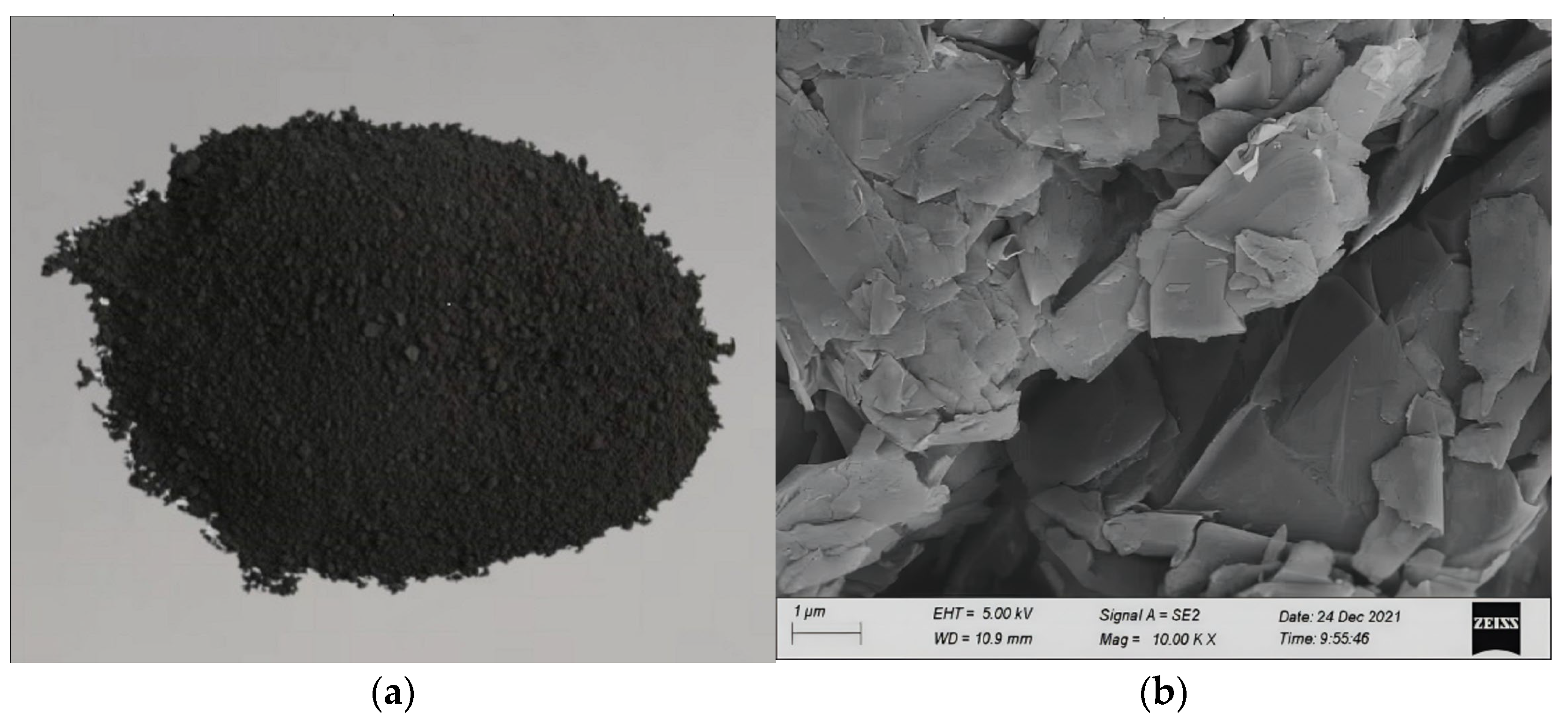
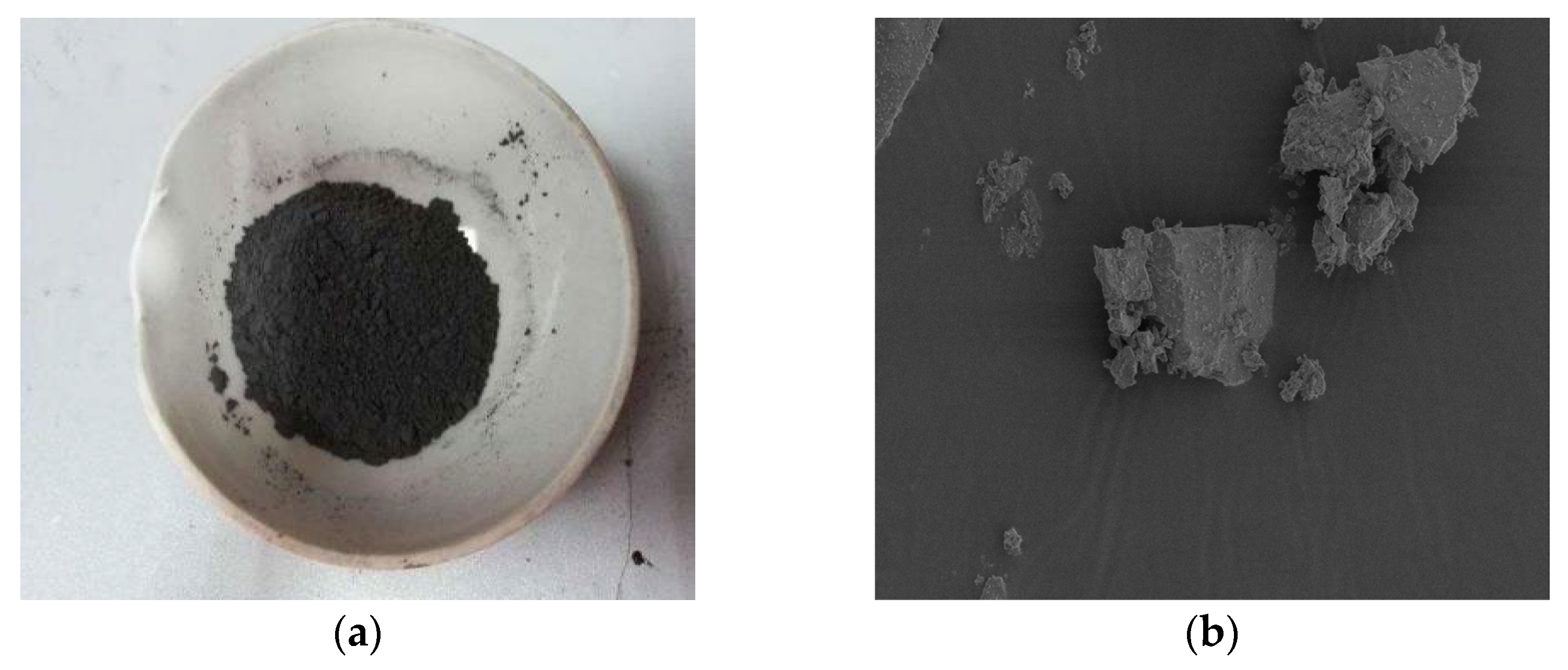
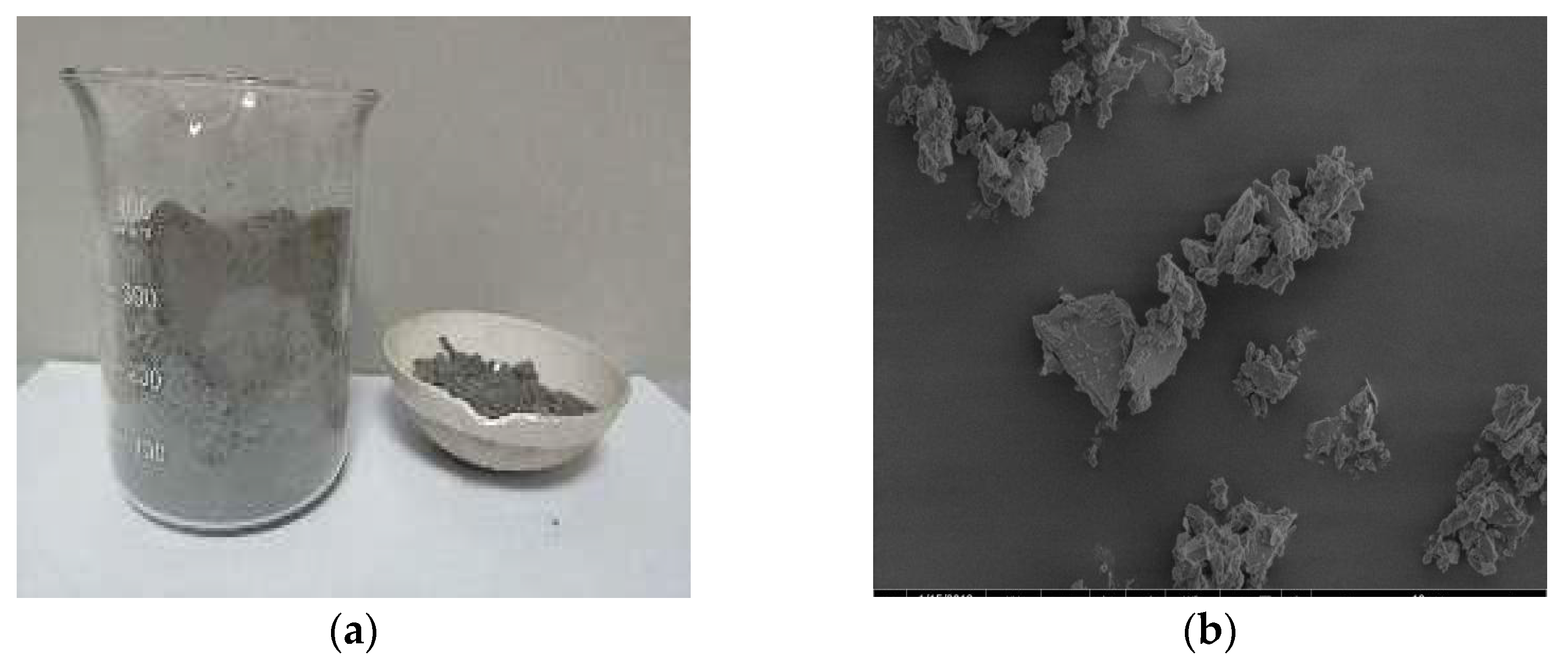
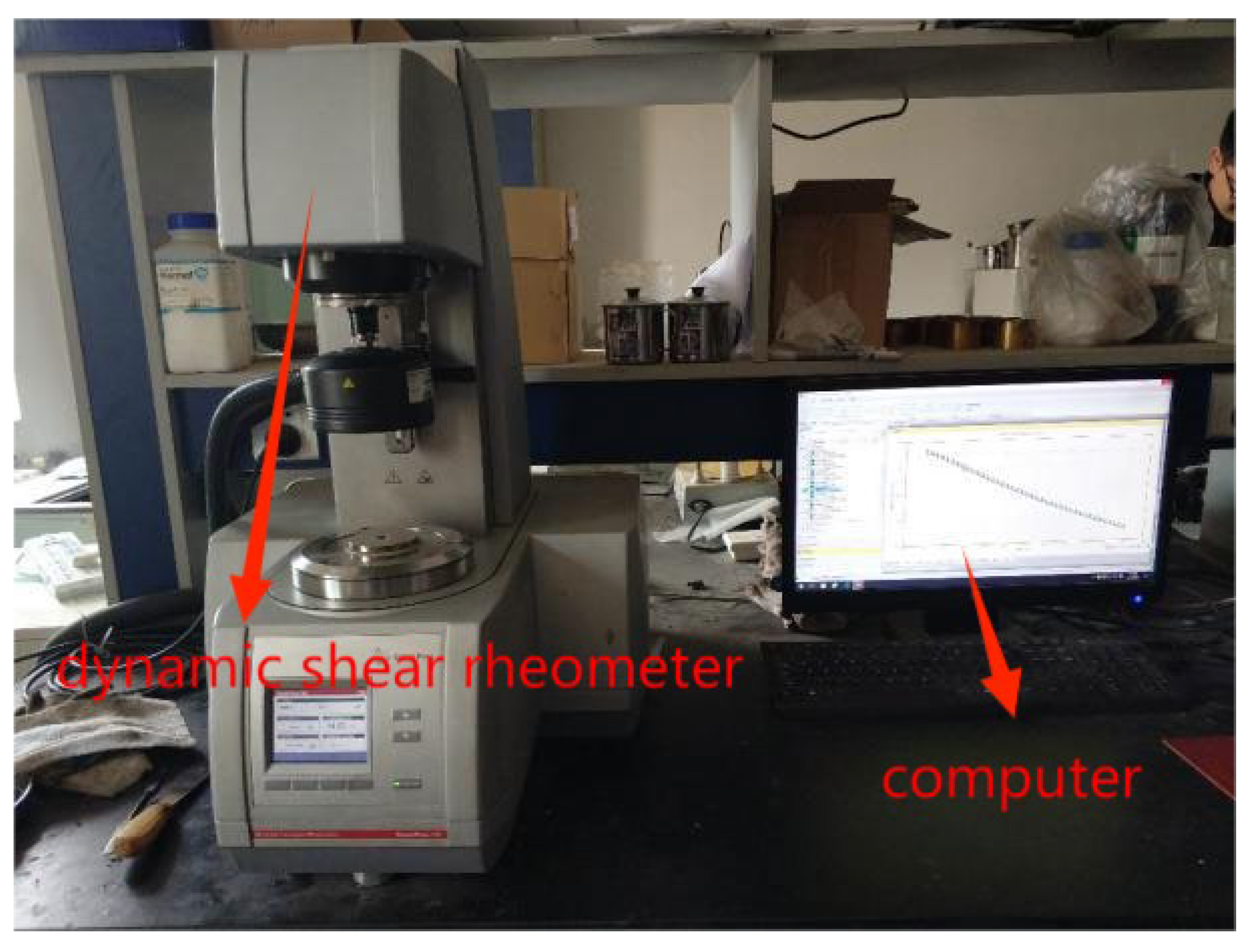
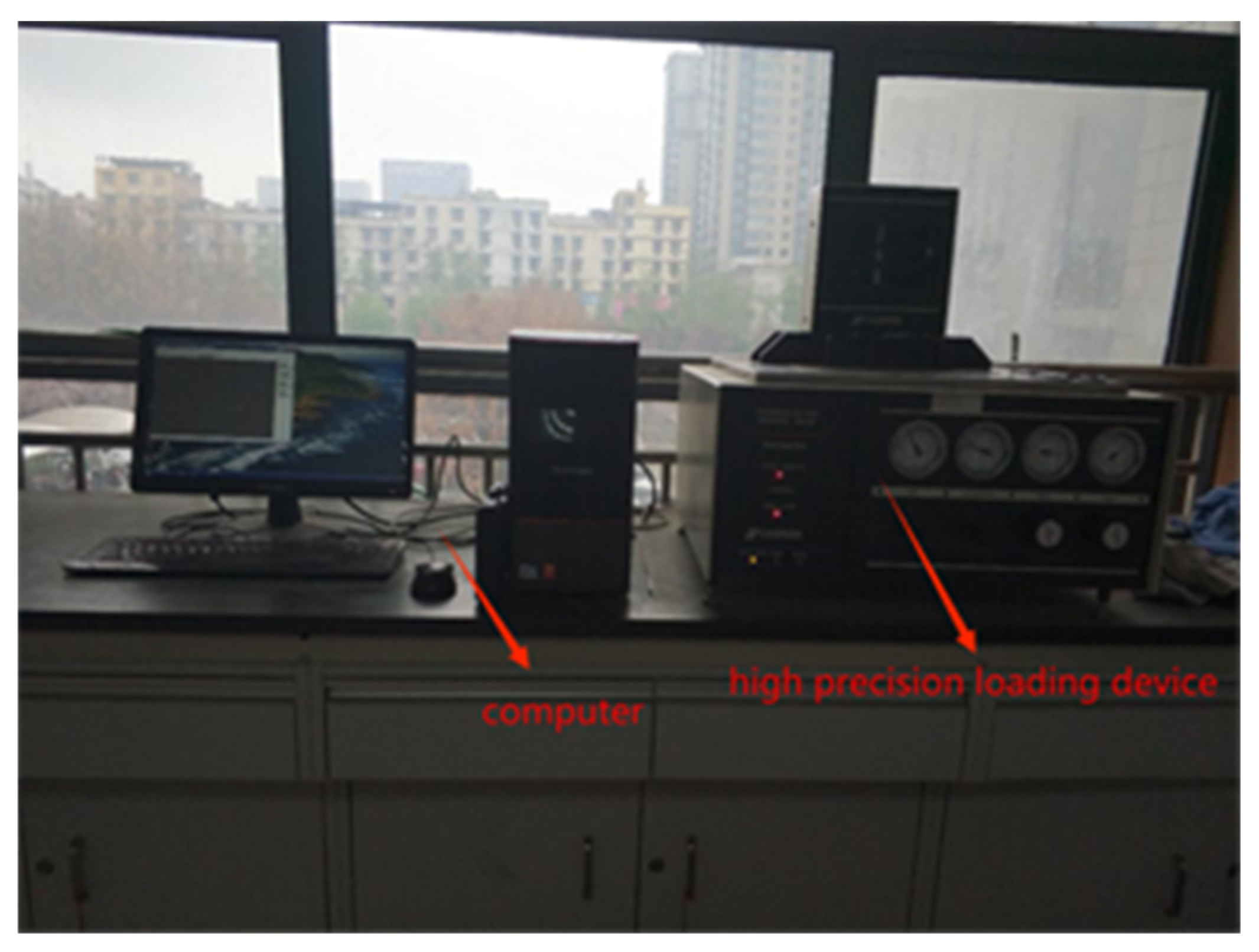
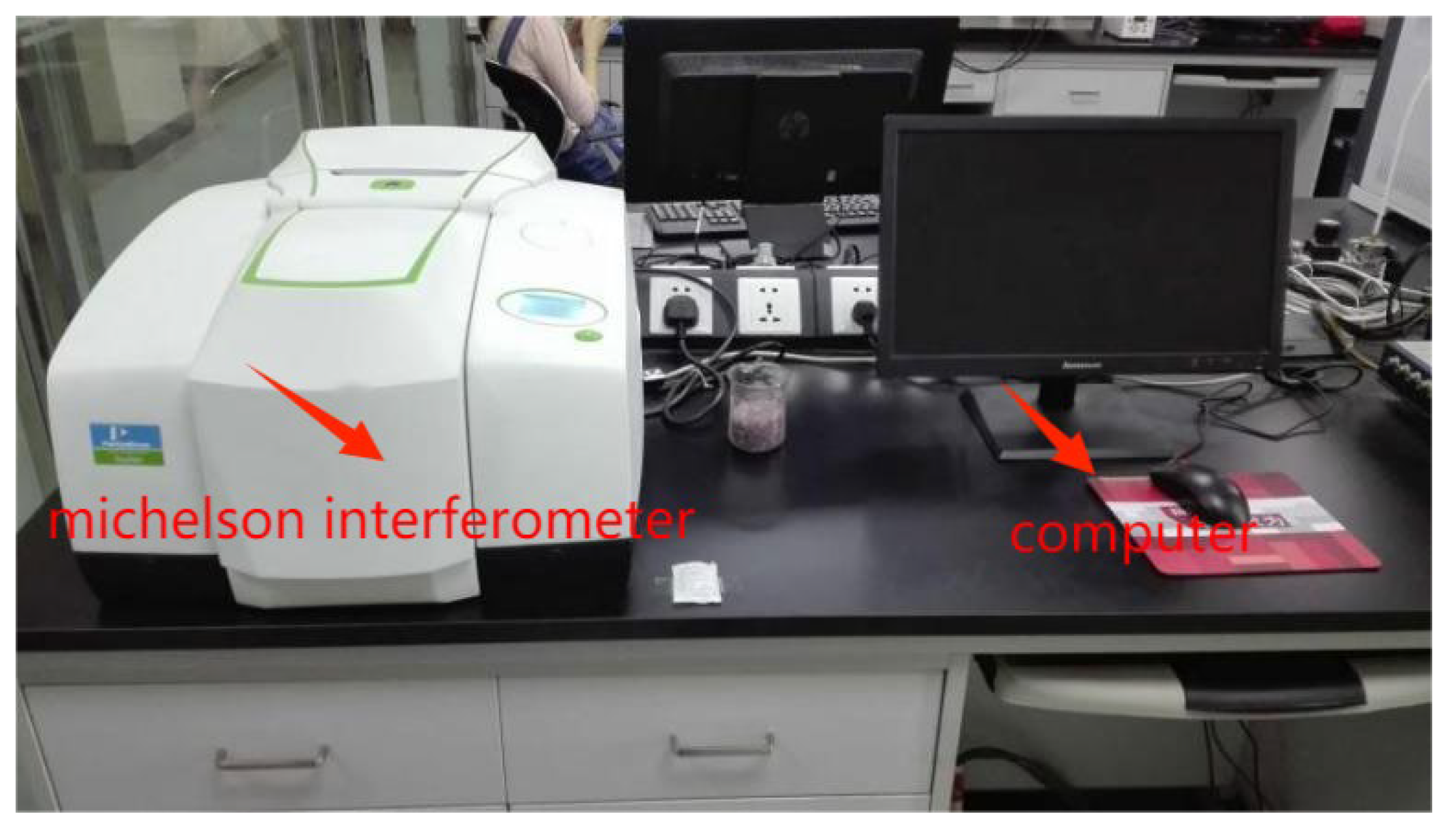
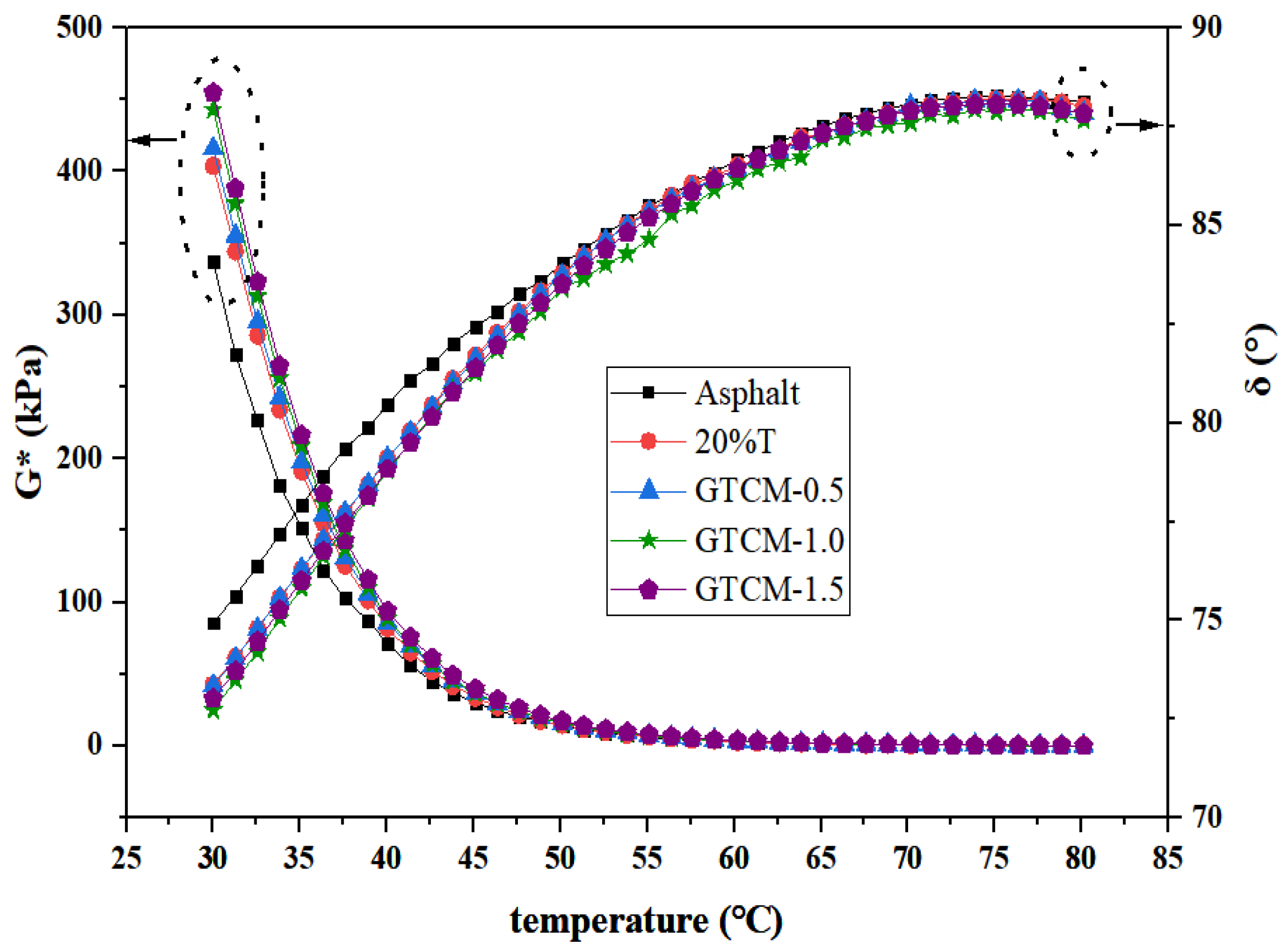
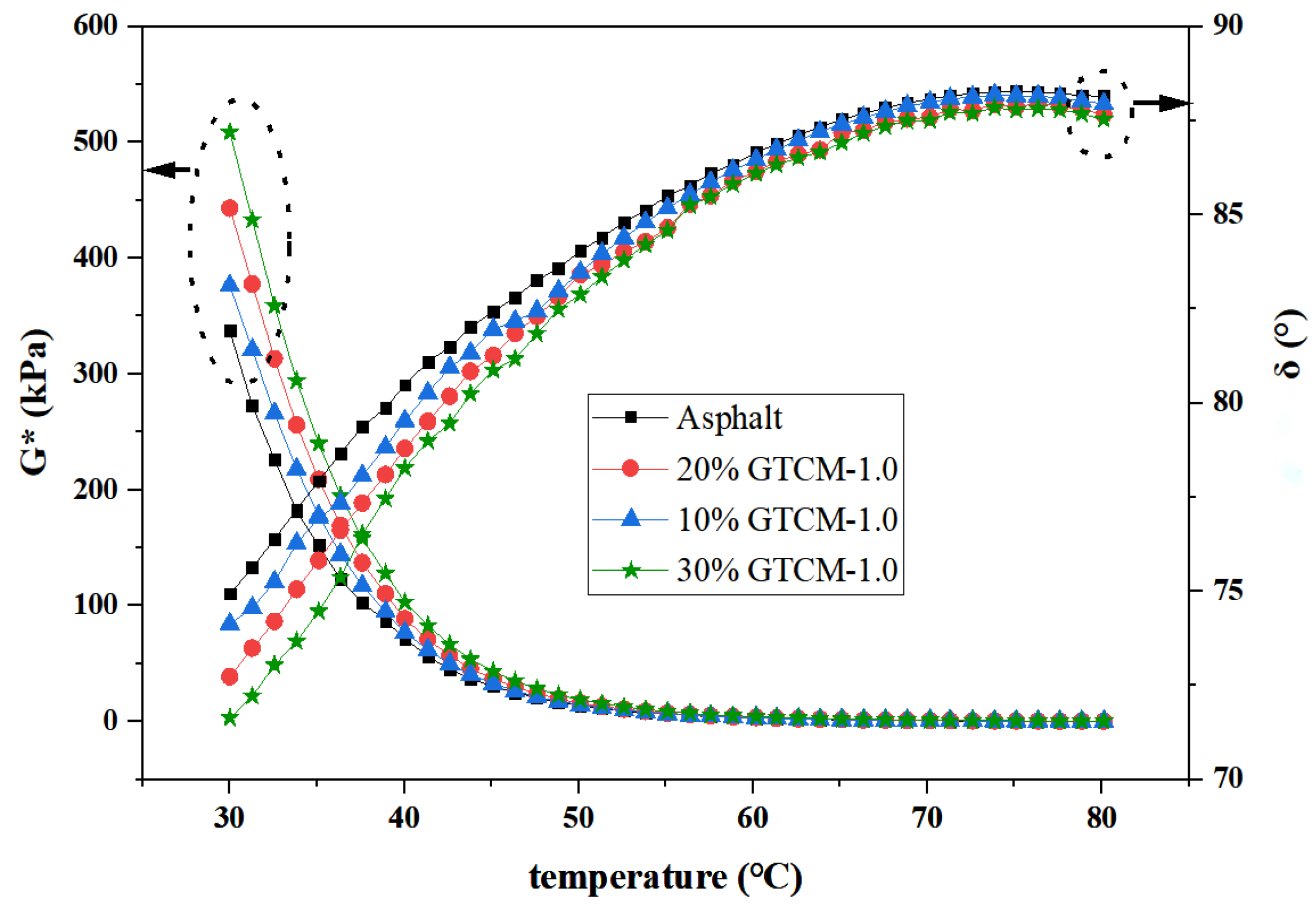
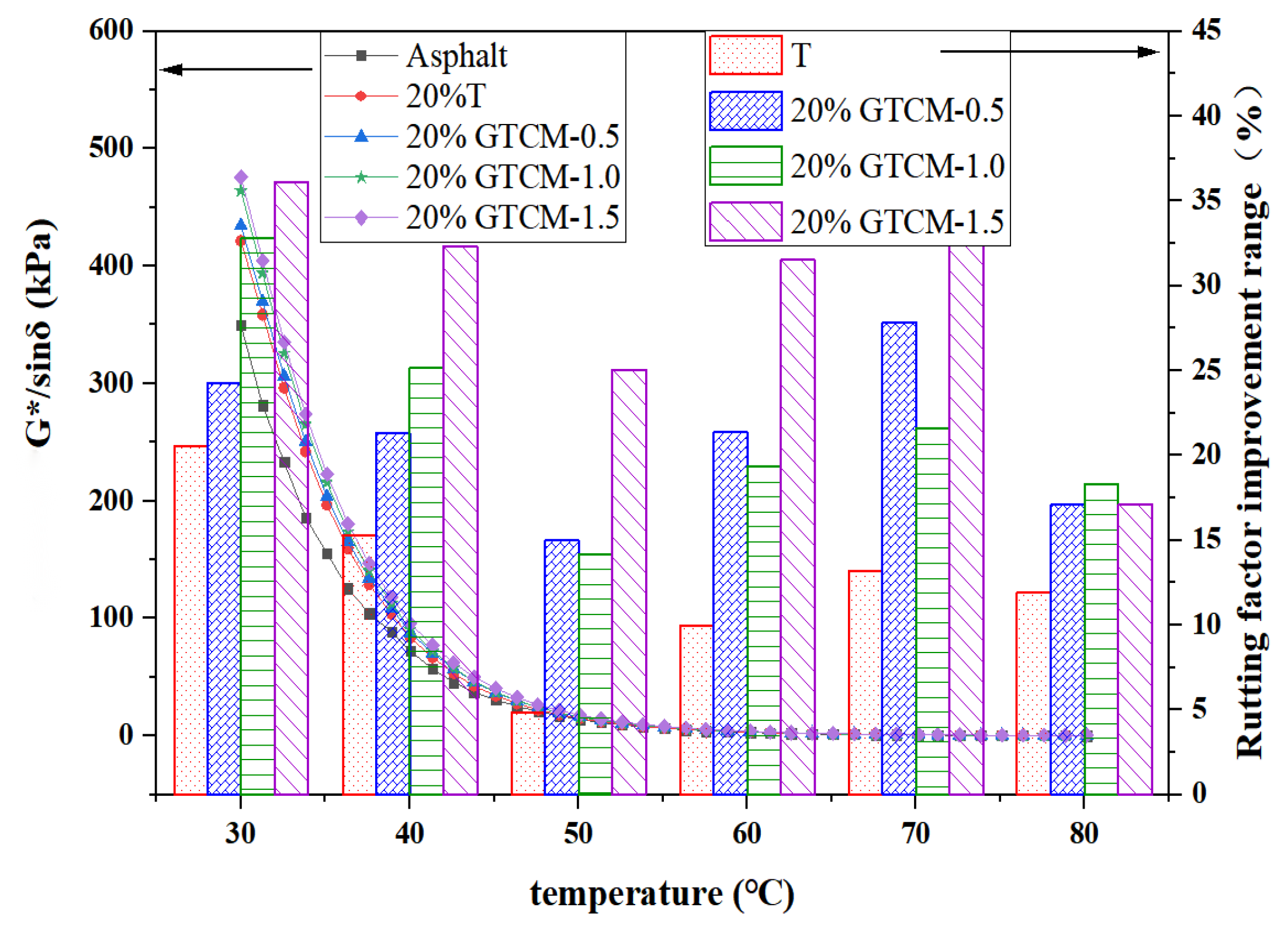
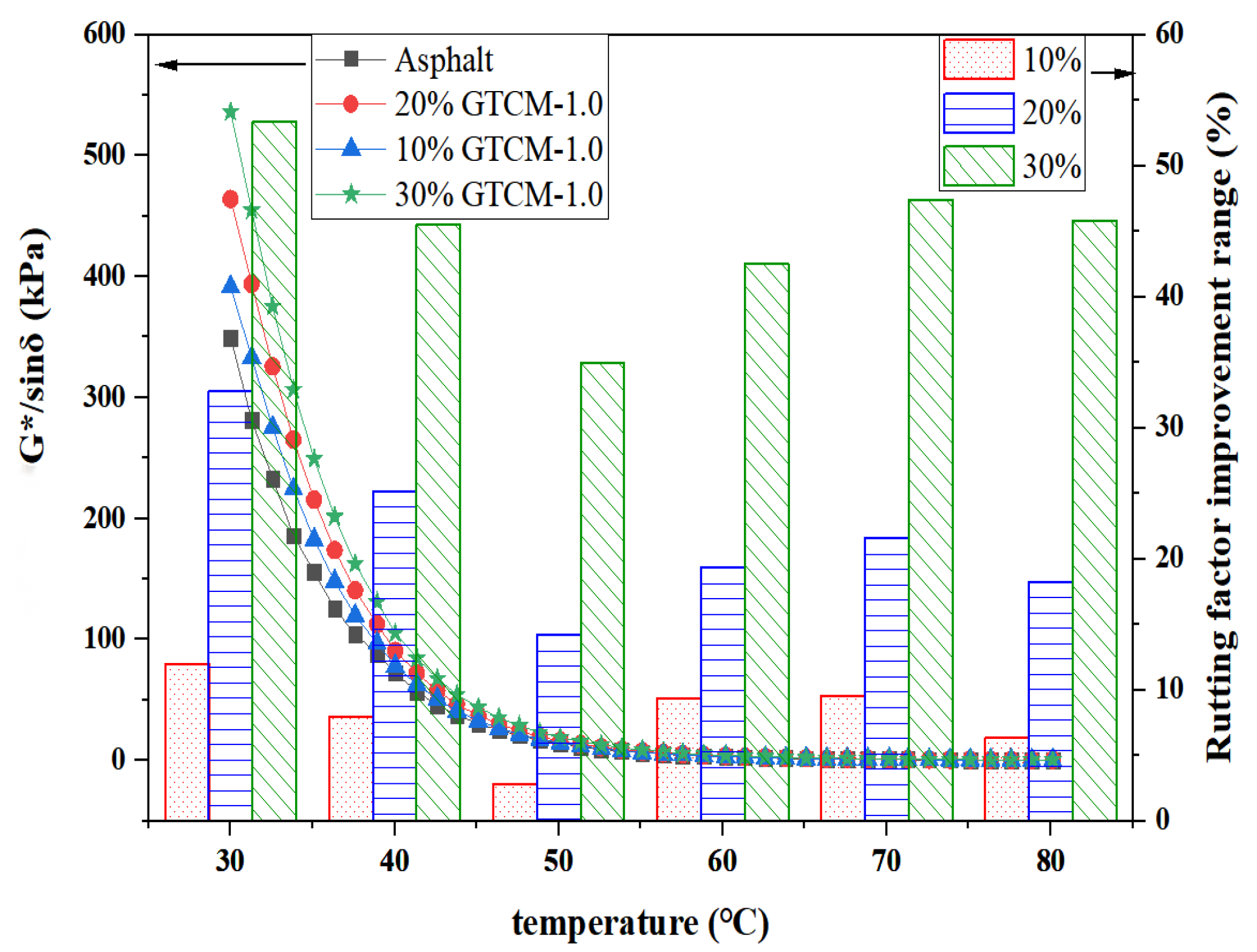
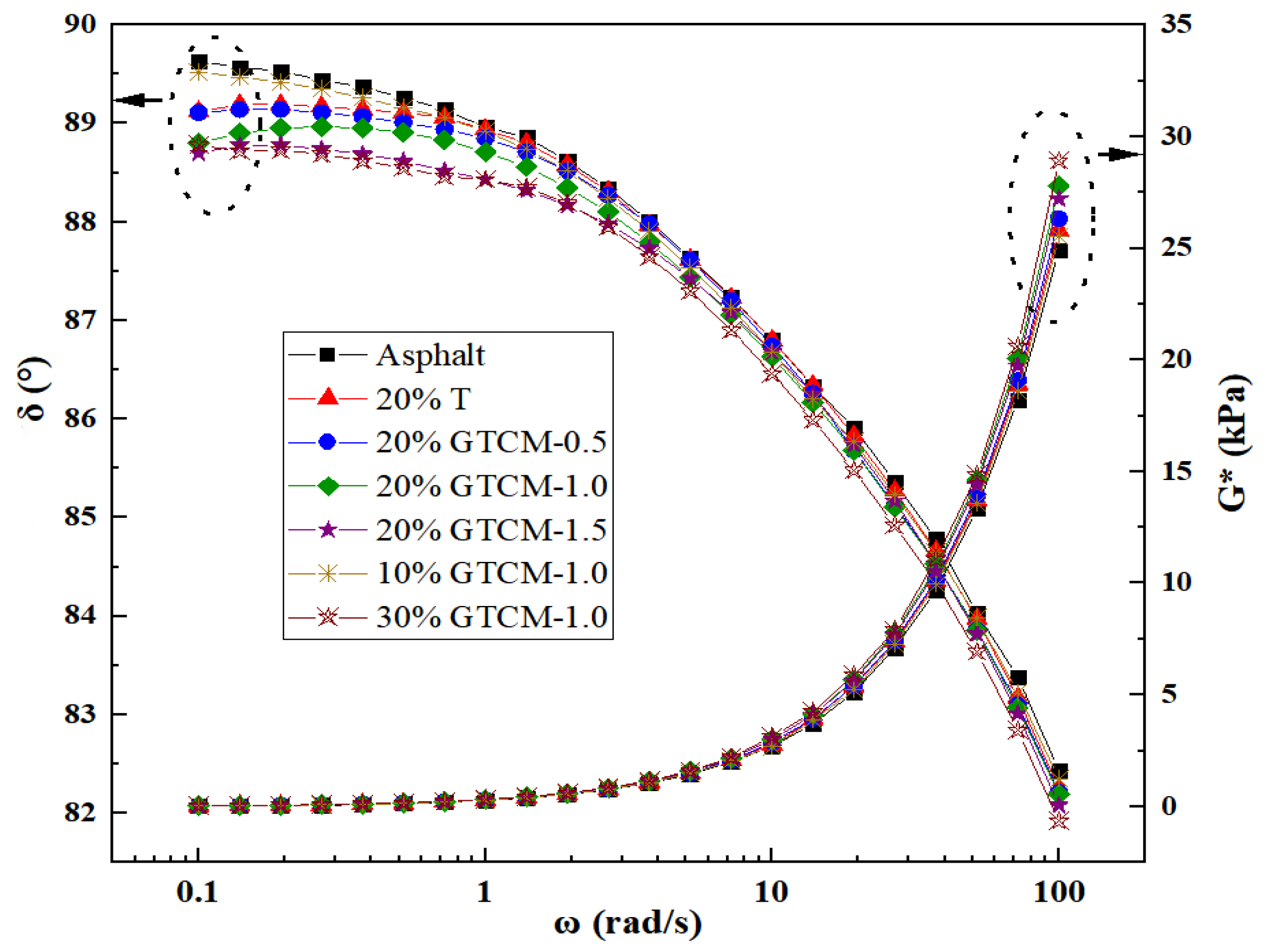

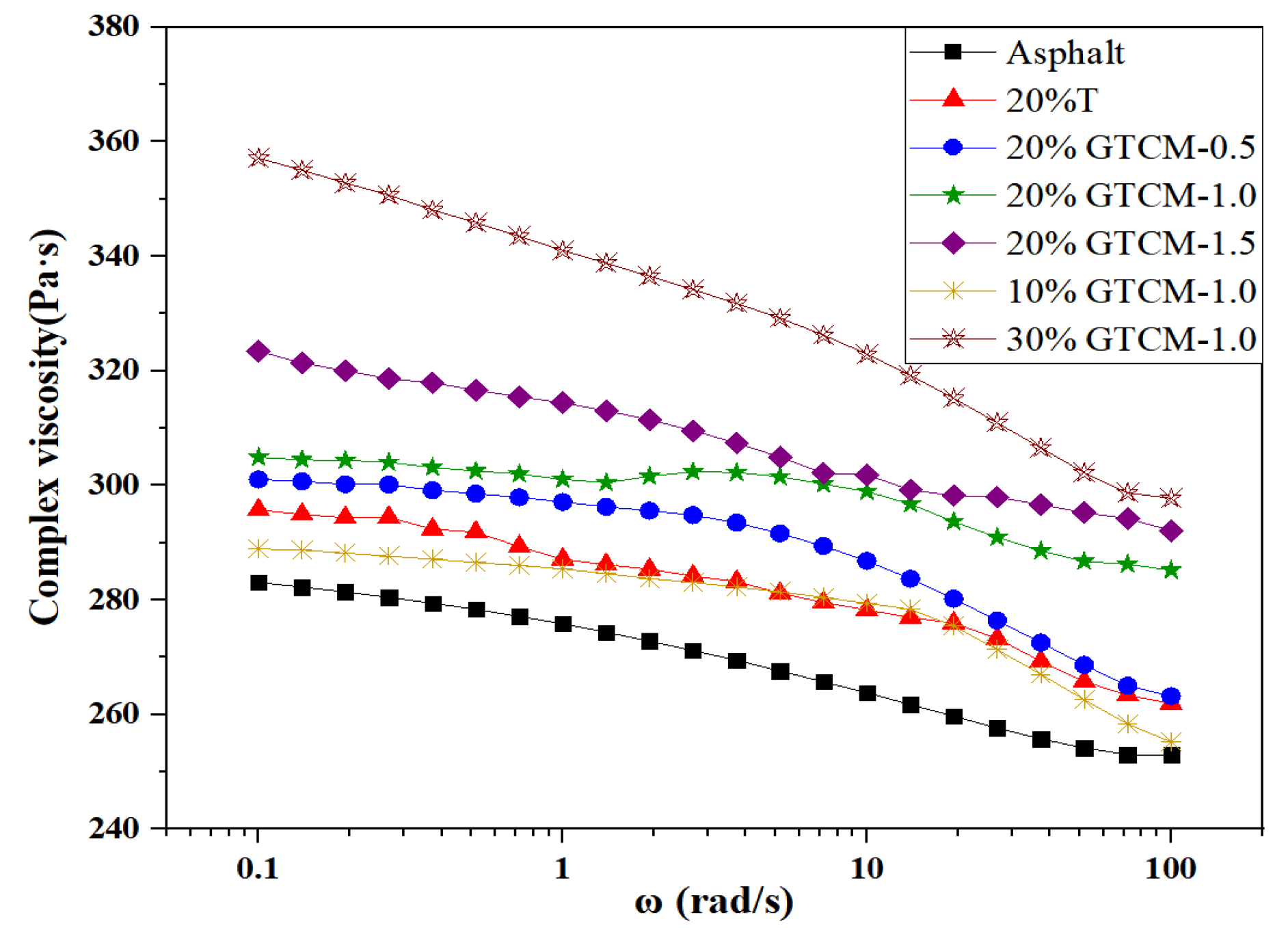


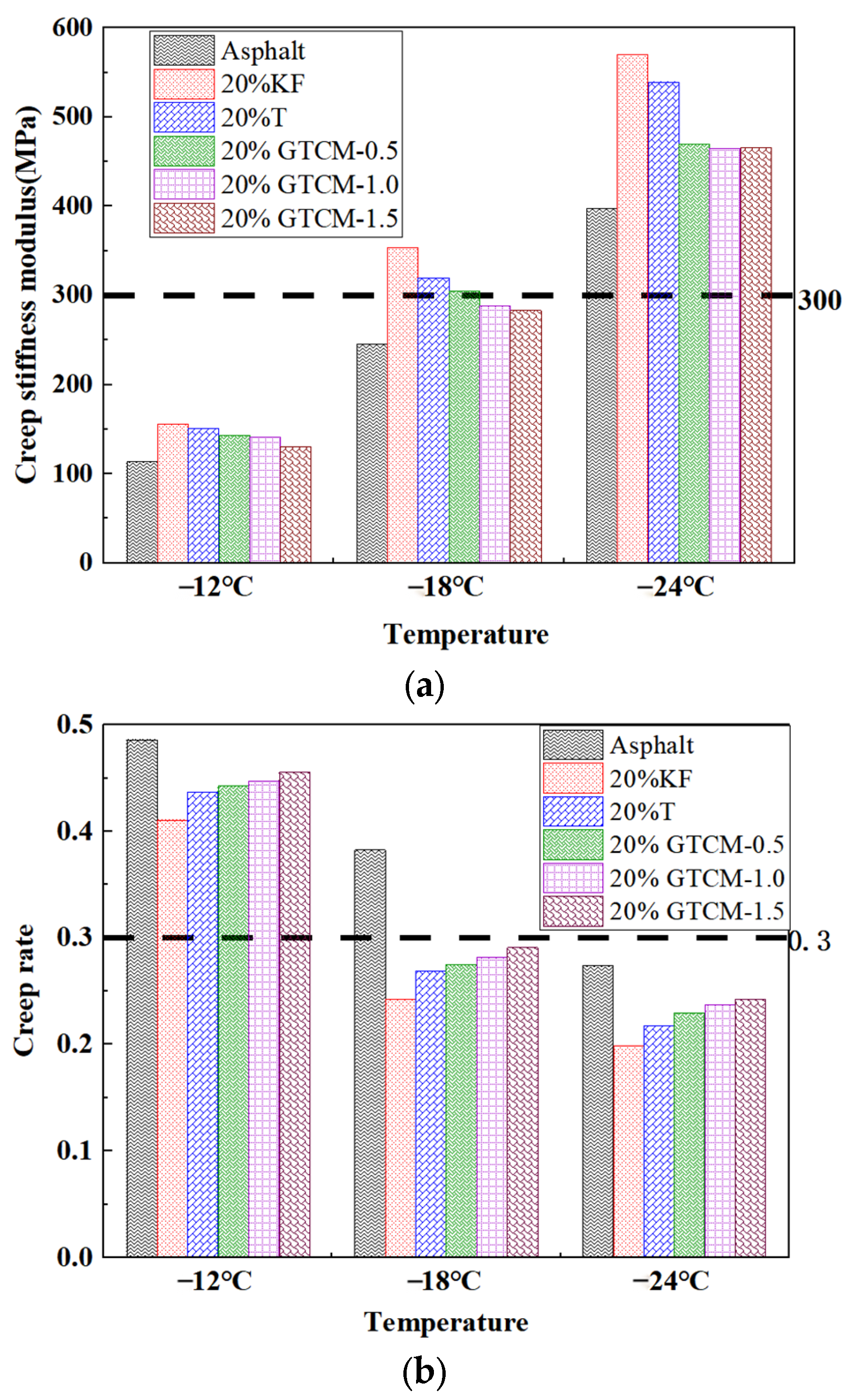
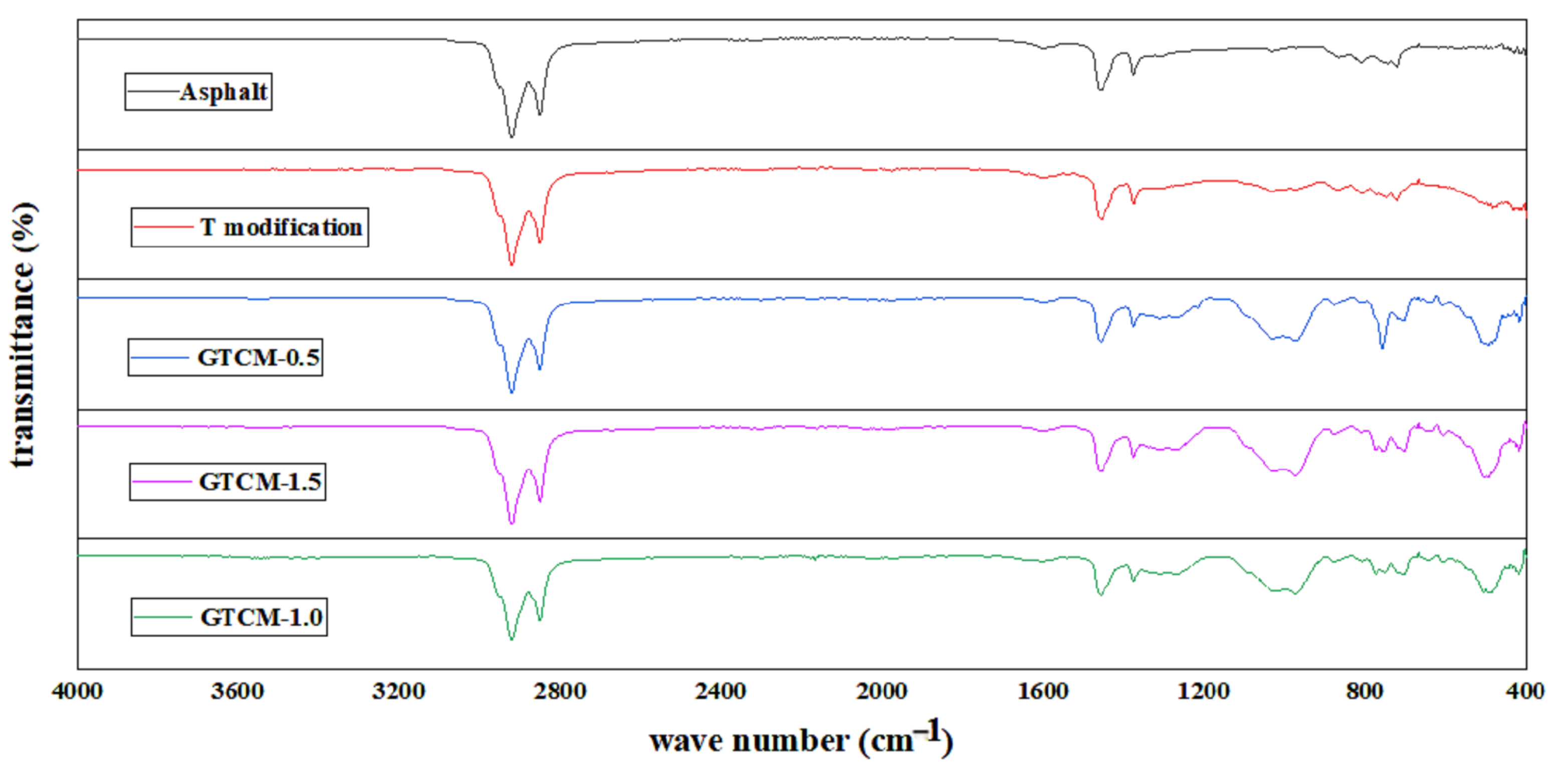
| Performance Parameter | Appearance | Purity (wt%) | Thickness (nm) | Specific Surface Area (m2/g) | Layer Diameter (μm) |
|---|---|---|---|---|---|
| measured value | black powder | 95 | 1.35 | 89 | 47 |
| Essential Component | SiO2 | Al2O3 | B2O3 | MgO | FeO | Fe2O3 | CaO | TiO2 | Na2O | H2O |
|---|---|---|---|---|---|---|---|---|---|---|
| content (%) | 33.54 | 31.98 | 11.21 | 0.49 | 2.88 | 16.32 | 0.01 | 0.28 | 0.72 | 2.51 |
| Order Number | Types | Dosage (%) |
|---|---|---|
| 1 | asphalt | - |
| 2 | T asphalt mastic | 20 |
| 3 | GTCM-0.5 asphalt mastic | 20 |
| 4 | GTCM-1.0 asphalt mastic | 10; 20; 30 |
| 5 | GTCM-1.5 asphalt mastic | 20 |
| Test Project | Unit | Test Results | |
|---|---|---|---|
| Penetration (25 °C) | 0.1 mm | 64 | |
| Penetration index PI | - | −1.37 | |
| Ductility (10 °C) | cm | 38.3 | |
| Softening point (R&B) | °C | 47.9 | |
| 60 °C Kinetic viscosity | Pa·s | 226 | |
| After TFOT | Quality change | % | 0.12 |
| Penetration ratio | % | 74.1 | |
| Ductility (10 °C) | cm | 12.4 | |
| Asphalt Type | Dosage (%) | Needle Penetration (100 g, 5 s, 0.1 mm) | Residual Needle Penetration Ratio (%) | Softening Point (°C) | |||||||
|---|---|---|---|---|---|---|---|---|---|---|---|
| Before Aging | After Aging | Before Aging | Equivalent Softening Point T800 | After Aging | Increment | ||||||
| 15 °C | 25 °C | 30 °C | PI | 25 °C | |||||||
| Matrix asphalt | - | 25 | 75 | 138 | −1.317 | 43 | 57.2 | 41.5 | 45.5 | 49.5 | 8.0 |
| T asphalt | 10 | 23 | 65 | 116 | −1.031 | 40 | 61.8 | 49.0 | 48.0 | 52.0 | 3.0 |
| 20 | 22 | 61 | 107 | −0.909 | 39 | 63.7 | 51.0 | 49. | 52.5 | 1.5 | |
| 30 | 20 | 58 | 99 | −0.895 | 38 | 64.3 | 52.5 | 50.0 | 53.5 | 1.0 | |
| GTCM-0.5 | 10 | 24 | 64 | 115 | −0.826 | 41 | 63.7 | 49.5 | 49.0 | 52.0 | 2.5 |
| 20 | 22 | 61 | 103 | −0.669 | 40 | 65.3 | 52.0 | 50.0 | 53.0 | 1.0 | |
| 30 | 21 | 57 | 95 | −0.536 | 38 | 67.6 | 53.0 | 51.5 | 54.5 | 1.5 | |
| GTCM-1.0 | 10 | 24 | 63 | 109 | −0.581 | 42 | 66.2 | 50.5 | 50.0 | 52.5 | 2.0 |
| 20 | 23 | 60 | 98 | −0.369 | 40 | 66.9 | 52.5 | 51.5 | 53.5 | 1.0 | |
| 30 | 22 | 55 | 91 | −0.244 | 40 | 71.3 | 55.5 | 53.0 | 56.5 | 1.0 | |
| GTCM-1.5 | 10 | 24 | 62 | 107 | −0.446 | 42 | 67.6 | 51.5 | 50.5 | 53.0 | 1.5 |
| 20 | 24 | 59 | 100 | −0.228 | 41 | 69.0 | 53.0 | 52.0 | 54.0 | 1.0 | |
| 30 | 23 | 55 | 93 | −0.115 | 40 | 72.9 | 56.5 | 53.5 | 57.5 | 1.0 | |
Disclaimer/Publisher’s Note: The statements, opinions and data contained in all publications are solely those of the individual author(s) and contributor(s) and not of MDPI and/or the editor(s). MDPI and/or the editor(s) disclaim responsibility for any injury to people or property resulting from any ideas, methods, instructions or products referred to in the content. |
© 2023 by the authors. Licensee MDPI, Basel, Switzerland. This article is an open access article distributed under the terms and conditions of the Creative Commons Attribution (CC BY) license (https://creativecommons.org/licenses/by/4.0/).
Share and Cite
Guo, T.; Chen, H.; Tang, D.; Ding, S.; Wang, C.; Wang, D.; Chen, Y.; Li, Z. Rheological Properties of Composite Inorganic Micropowder Asphalt Mastic. Coatings 2023, 13, 1068. https://doi.org/10.3390/coatings13061068
Guo T, Chen H, Tang D, Ding S, Wang C, Wang D, Chen Y, Li Z. Rheological Properties of Composite Inorganic Micropowder Asphalt Mastic. Coatings. 2023; 13(6):1068. https://doi.org/10.3390/coatings13061068
Chicago/Turabian StyleGuo, Tengteng, Haijun Chen, Deqing Tang, Shengquan Ding, Chaohui Wang, Decai Wang, Yuanzhao Chen, and Zhenxia Li. 2023. "Rheological Properties of Composite Inorganic Micropowder Asphalt Mastic" Coatings 13, no. 6: 1068. https://doi.org/10.3390/coatings13061068





